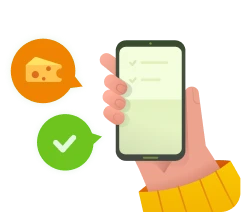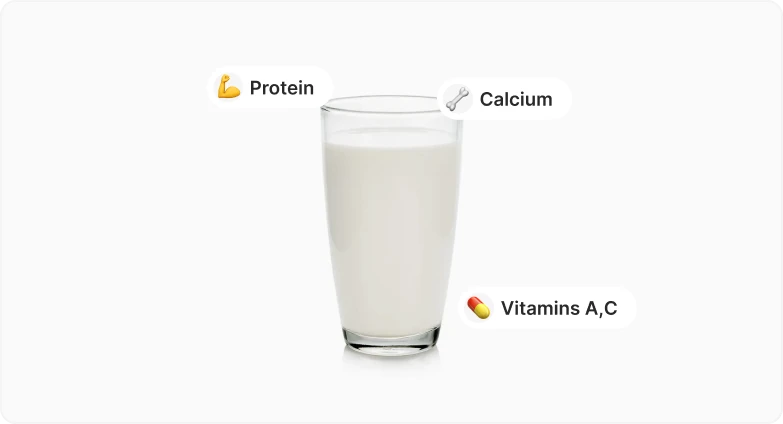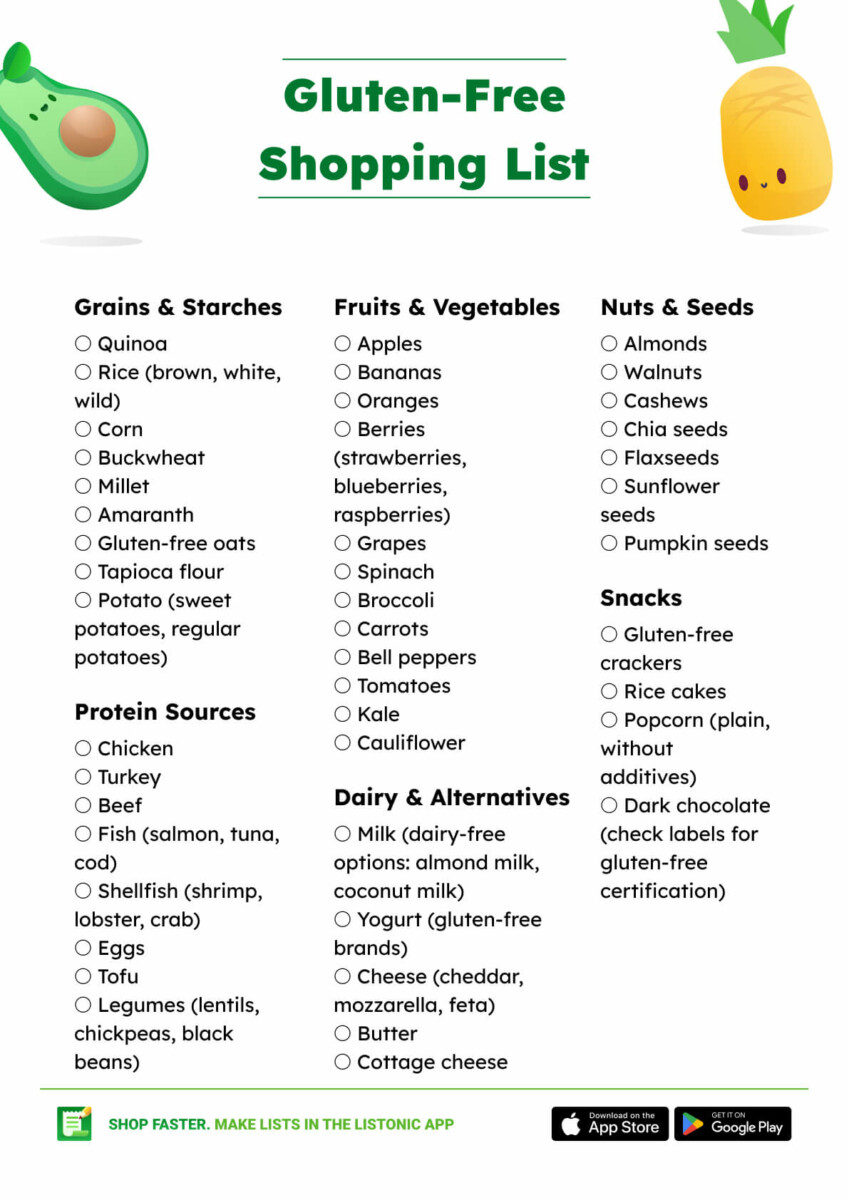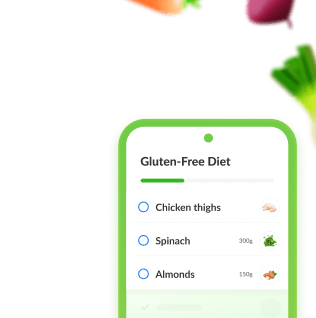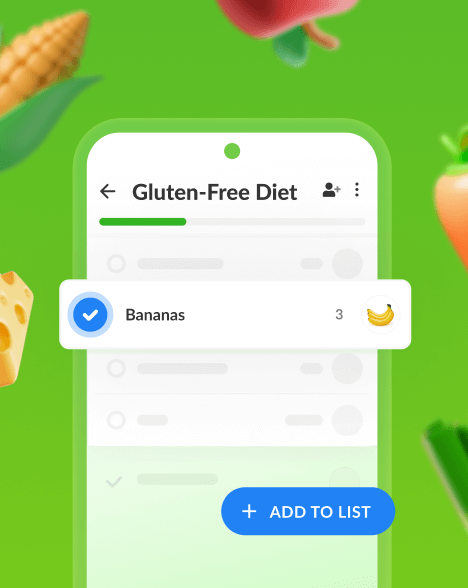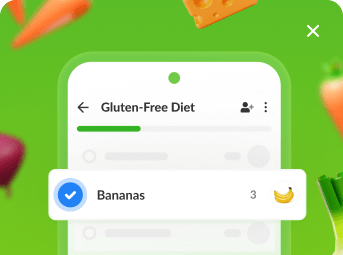Privacy Policy | Terms of services | Cookies Policy | © 2006-2024 Listonic. All rights reserved. Listonic Dev, and Listonic Ads are part of Listonic.

Gluten-Free Food List (+ Shopping List and PDF)
June 19, 2023
It’s no surprise why going gluten-free is so popular nowadays – it’s not only recommended for people with gluten sensitivity, but also those simply looking for a healthier lifestyle. In this article, you will find everything you need to get started: a gluten-free food list and a convenient shopping list to help you navigate your gluten-free journey with ease.
Table of contents
Gluten-Free Shopping List
The Basics of the Gluten-Free Diet
Food List Breakdown
What Else to Keep in Mind?
Conclusions
Gluten-Free Food List
Grains & Starches
Meat & protein sources
Fruits & Vegetables
Dairy & Alternatives
Nuts and Seeds
Snacks and Treats
The Basics of the Gluten-Free Diet
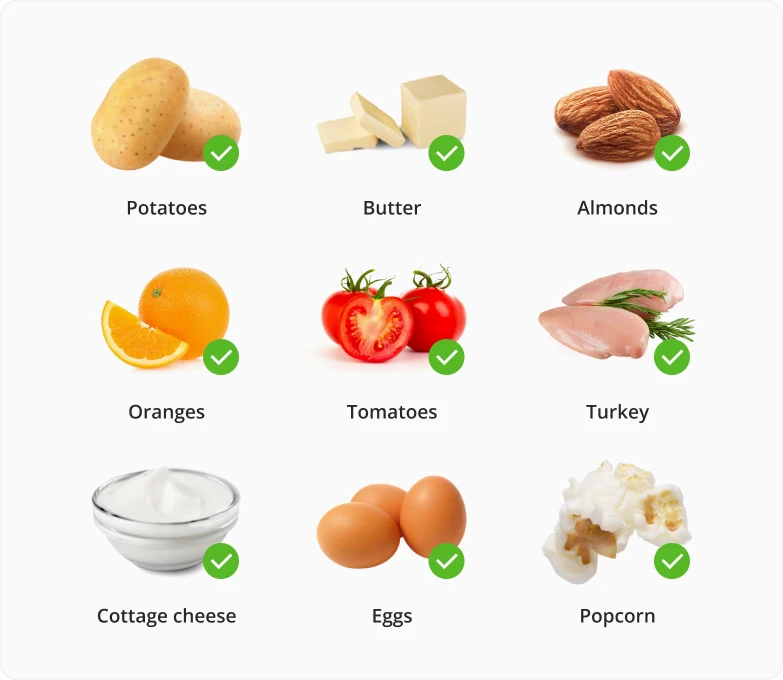
The world of a gluten-free lifestyle might seem overwhelming at first, but with a little bit of effort and attention to detail, you’ll be able to navigate this new dietary landscape with ease.
Look out for gluten found in wheat, barley, rye and their derivatives which can trigger health problems. In fact, reviewing food labels should become your second nature. Also, try to prevent accidental contamination from cross contact with non-gluten-free foods (such as crumbs left behind on kitchen surfaces or utensils). Just keep the items from your gluten-free food list completely separate.
When selecting a place to dine in at, opt for restaurants that provide a range of gluten-free options or even have dedicated menus which cater to the dietary needs of all customers including those with celiac disease or gluten sensitivity. Remember that you have every right to ask the staff about all methods they use in preparing meals.
Food List Breakdown
Naturally Gluten-Free Foods
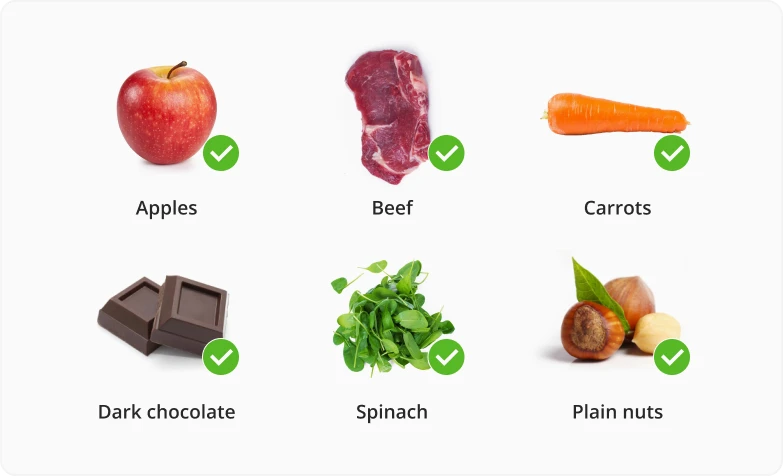
Red Meat & Poultry
Meat is safe for those who need to stay away from gluten due to their dietary restrictions or sensitivities, and it’s also packed with some extra nutrients like amino acids. Don’t hesitate to add these delicious and nutritious options into your meals, unless you’re vegetarian. In that case, you can always put some tofu or tempeh on your gluten-free grocery list.
Fruits & Vegetables
Not only are they naturally gluten-free but also come with an abundance of crucial nutrients like vitamins, minerals, and dietary fiber. Eating a varied diet filled with many different colors ensures that you’re getting everything needed for complete wellness each day. The same applies for legumes – the more varied, the better.

Chocolate
Pure chocolate in its natural form doesn’t contain gluten. Also, chocolate production usually uses gluten-free ingredients such as cocoa beans and sugar. That said, pay special attention when indulging in products with added ingredients like cookies or crispy bits that could contain hidden sources of gluten.
Reading labels carefully and opting for certified gluten-free chocolates or products labeled as such can give you peace of mind and ensure safe consumption on a gluten-free diet.
Dairy
Dairy is tricky. It’s typically free from the notorious gluten, but you should watch out for flavored dairy items because they often could contain traces of gluten. To play it safe, stick with plain or unflavored options (like UHT milk and pure Greek yogurt) & take time to scrutinize every label before making a purchase.
Nuts and Seeds
Plain nuts and seeds are naturally safe to eat on a gluten-free diet. Loaded with healthy fats, fiber, and protein, they will be a great addition to gluten-free cereal or other meals. You can also eat them separately as a nice gluten-free snack.
Beverages
Opting for water is always a smart choice for staying hydrated without the worry of accidentally consuming unwanted gluten. When it comes to teas, herbal varieties like chamomile or peppermint typically don’t contain any traces of the protein either, since they’re brewed using only natural ingredients.
Coffee lovers can relax too – as long as you go for plain black coffee without added flavorings or creamers that may contain wheat based thickeners.
Gluten-Free Substitutes
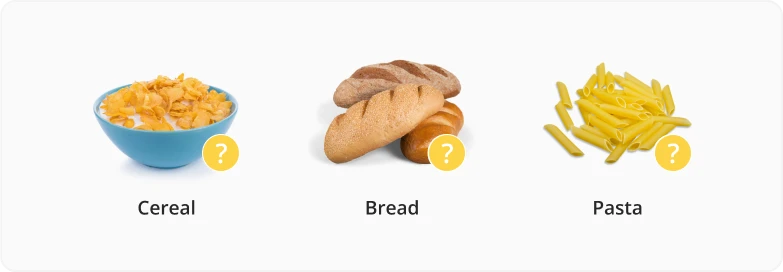
Gluten-Free Baked Goods
If you’re looking for gluten-free pizzas or breads, double-check the ingredients and manufacturing practices. You’ll want products containing flours made from rice almond coconut or tapioca; these are all naturally free from this pesky gluten.
Don’t take any chances – make sure labels read “certified gluten-free” so you know they’ve met rigorous standards during production. As in the previous cases, look out for cross contamination risks that could potentially sneak through – and make sure to choose items made in exclusive gluten-free facilities whenever possible.
Gluten-Free Cereal
Stick with grains like rice, corn quinoa and gluten-free oats. Check the labels for any added flavorings or mix ins, as they often contain gluten or be produced in facilities that handle it.
Here again, as long as you look for dedicated gluten-free symbols or certifications on your cereal choices, you can enjoy a safe and delicious breakfast without worrying about any repercussions.
Gluten-Free Processed Food
Avoid wheat, barley, rye or malt. Settle on items made from gluten-free ingredients and manufactured in facilities with stringent protocols in place, and remember: don’t miss out on the important nutrients found in whole foods by relying solely on processed options.
Get a Gluten-Free Grocery List on Your Phone!
Add & remove items
Sort items by store aisles
Share the list with your partner


What Else to Keep in Mind?
What Foods to Avoid?
Steer clear of food items that contain gluten, so ingredients like wheat, barley, rye, and their derivatives. Be mindful of products such as bread, pasta, cereals, pastries, baked goods, crackers, beer, and certain condiments and sauces that may harbor gluten.
To maintain a gluten-free lifestyle, carefully read labels and remain vigilant about hidden sources of gluten in processed foods.
Is All Alcohol Gluten-Free?
Though distilled spirits such as rum, tequila and vodka are generally considered safe in terms of their gluten content; certain other beverages like beer and malt based drinks can pose problems.
Here again, your best bet is to pay close attention to labels (and where possible seek out expert advice) regarding the specific drink you're thinking of consuming when trying to avoid exposure to gluten.
Plus, be aware of any issues around contamination during preparation or handling - which could throw off even careful label readers.
Conclusions
Eating gluten-free doesn't have to mean sacrificing flavor or nutrients in your daily meals. We hope that our helpful tips along with a gluten-free shopping list will help you navigate the switch is easier than ever before.
Don't forget about double-checking labels for any unexpected sources of gluten along the way - certified products are also often available which are highly recommended by experts in this field, and keep in mind the list of gluten-free foods to avoid to enjoy all the benefits of your new gluten-free lifestyle.
If you want to make the whole process even easier, open our gluten-free shopping list in the free Listonic app that will help you make your dietary preparations so much faster and easier.
